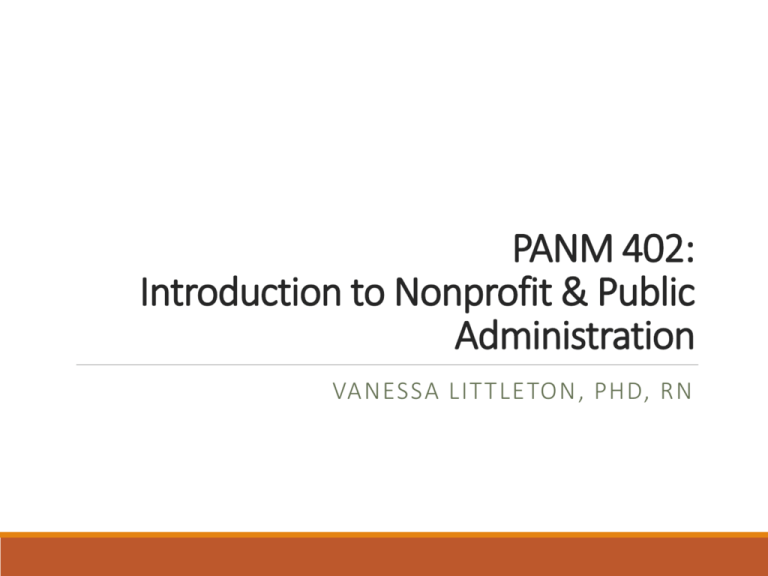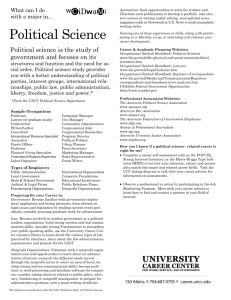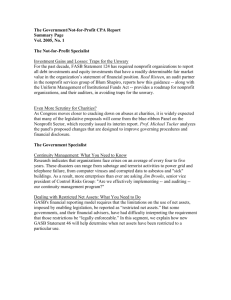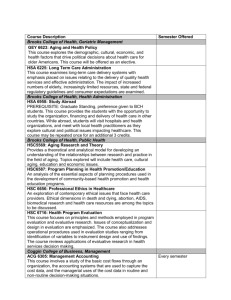Module 1 Course Overview
advertisement

PANM 402: Introduction to Nonprofit & Public Administration VANESSA LIT TLETON, PHD, RN Today’s Agenda Student introductions Instructor introduction Syllabus review Course expectations Public administration Nonprofit organizations Student Introductions Your name (nickname) One interesting fact about yourself Dream job Share a picture with the professor Meet the Professor Your name (nickname) One interesting fact about yourself Dream job Share a picture with the professor 30 Things About Me My Teaching Philosophy “The teacher if he is indeed wise does not teach bid you to enter the house of wisdom but leads you to the threshold of your own mind. “ Kahlil Gibran, artist The Prophet Course Overview (Proposed) This course is designed to introduce students to the nonprofit and public sectors by providing students with foundational knowledge to understand the role and purpose of nonprofit organizations and government agencies in contemporary American society. Students are introduced to the concepts, principles and practices necessary to effectively function in public agencies, nonprofit organizations, and collaborative systems. Students gain basic knowledge and skills in assessing community needs, developing program descriptions, developing operating budgets, managing personnel, and serving diverse populations. Course Expectations Start on time; finish on time Attendance/Missing class Use of technology during class Professional writing Plagiarism Communicating with the professor Communicating with the group Mutual accountability & respect Check iLearn at least twice per week Course Textbooks Course on iLearn General questions – use Ask the Professor forum on iLearn Office hours – Wednesday 10 a.m.-12 p.m. Ocean Hall, Suite C105 (831) 582-4043 My email – Vlittleton@csumb.edu Will respond within 24 hours M-F and 48 hours on weekends and holidays Nonprofit & Public Administration AN OVERVIEW Sector Differences Private Sector Public Sector Economy Nonprofit Sector Public Administration Defined The formation and implementation of public policy (Holzer & Schwester) The management of public affairs and the implementation of public policy (Shafritz, Russell, & Borick) Examples: Firefighters FDA inspectors CIA agents Police officers Weather service personnel (National Oceanic and Atmospheric Administration) Sewer crawlers Seismologist at National Earthquake Information Center (NEIC) What did President Obama Mean? You Didn't Build That You Didn't Build That In Context Defining Public Administration Political Public administration cannot exist outside of its political context. Legal Because public administration is what the state does, it is both created and bound by an instrument of the law. Managerial Administration is a branch of management often divided into public, private, and nonprofit. Occupational Public administration is whatever public employees do. Political Definitions of Public Administration Public administration is both direct and indirect. ◦ Direct – provision of services like mortgage insurance, mail delivery, and electricity. ◦ Indirect – when the government pays private contractors to provide goods and services to citizens (space shuttle, dams). Political Definitions of Public Administration Public administration is a phase in the policymaking cycle. Political Definitions of Public Administration Public administration is implementing the public interest. Public administration is doing collectively that which cannot be done so well individually. GI Bill, Small Business Administration loans, Federal Housing Administration loans, Amtrak Legal Definitions of Public Administration Because public administration is what a state does, it is both created and bound by an instrument of the law. Public administration is the law in action. ◦ Public administration is inherently the execution of a public law. ◦ Every application of a general law is necessarily an act of administration. ◦ In the United States, the Constitution of 1787 is the law of the land. All legislation must conform. Legal Definitions of Public Administration Public administration is regulation. ◦ It is government telling citizens and businesses what they may or may not do. ◦ Regulation is one of the oldest functions of government. Managerial Definitions of Public Administration Public administration is the executive function of government. ◦ Government agencies put into practice legislative acts that represent the will of the people. Managerial Definitions of Public Administration Public administration is a management specialty. ◦ Top managers make the big decisions and are responsible for the overall success of the organization. ◦ Public administrators are found in middle management, the group responsible for the execution and interpretation of top management policies and the day-to-day operation of an organizational unit. Managerial Definitions of Public Administration Public administration is art, not science – or vice versa. ◦ Public administration is actually both. ◦ It requires judgment, panache, and common sense. ◦ It also requires technical skills that allow for the digestion and transference of information. ◦ Just because you have the academic credentials does not mean that you can function as a high level administrator. Occupational Definitions of Public Administration Public administration is an occupational category. ◦ It is whatever public employees in the world do. ◦ Most of the 18,000,000 public employees in the U.S. would not describe themselves as administrators, but they are. Occupational Definitions of Public Administration Public administration is idealism in action. ◦ Many people enter public service careers because they are idealists; they believe in and seek to advance noble principles. ◦ Idealism draws people into public administration because it provides them with worthwhile and exciting things to do with their lives. Occupational Definitions of Public Administration Public administration is an academic field. ◦ The study of the art and science of management and incorporates as its subject matter all of the political, social, cultural, and legal environments that affect the running of public institutions. ◦ Cross-disciplinary – political science, sociology, business administration, psychology, law, anthropology, medicine, forestry, and so on. Occupational Definitions of Public Administration Public administration is a profession. ◦ A body of academic and practical knowledge that is applied to the service of society. ◦ A standard of success theoretically measured by serving the needs of society rather than seeking purely personal gain. ◦ A system of control over the professional practice that regulates the education of new members and maintains both a code of ethics and appropriate sanctions. The Evolution of Public Administration The core content ◦ Organization theory ◦ Bureaucratic behavior ◦ Personnel management ◦ Public finance and budgeting ◦ Policy analysis ◦ Program evaluation ◦ Administrative ethics Four Critical Assumptions of Public Administration Administration is a unitary process that can be studied uniformly, at the federal, state, and local levels. The basis of study is management, not law. Public administration is art, not science – or vice versa Administration “has become, and will continue to be the heart of the problem of modern government.” Public or Government Agencies Federal State Local: Counties and Municipalities (e.g., cities, towns, townships, villages, boroughs) Special Purpose Government: (school districts, air pollution control districts) What do local governments do: https://www.youtube.com/watch?v=41wrvGSQem8 Quick Quiz 1. What is one definition of public administration? 2. What are the four categories (lenses) through which we will discuss public administration? 3. What are the four assumptions of public administration? Nonprofit Organizations Nonprofit Organizations The principal purpose is to promote a collective goal that is perceived to increase the benefit to the collective much greater in number than the organization’s board Decisions are made to increase the benefits to the constituency rather than to maximize profits The third sector Serves as a bridge between the individual and government Value-generating and value-maintaining Have no outside equity interests Are not precluded from generating a profit Characteristics of NPO Maintain a legal, incorporated status Private but provide a public service mission Governed by a voluntary board of directors Funded primarily through individual and corporate fees and/or contributions Operate under a financial system without profit Possess tax-exempt status from the IRS Conduct an annual, independent audit Private and Nonprofit https://www.youtube.com/watch?v=XKugEizYsic Nonprofit Organizations and Public Agencies Public sector (government) Nonprofit sector • No individual ownership • Run by elected or appointed (i.e., hired) government officials • Funded by public funds • No individual ownership – run by private individuals, not government officials • May be funded by public funds The Butterfly Effect Social Concerns Why Study Public and Nonprofit together? A Public Service Perspective Group Formation A Look Ahead Read Chapter 1 & 2 in Holzer & Schwester Read The Study of Administration (iLearn) Assignment due 2/5 Study of Administration Paper “A thing moderately good is not so good as it ought to be. Moderation in temper is always a virtue, but moderation in principle is always a vice.” Thomas Paine







